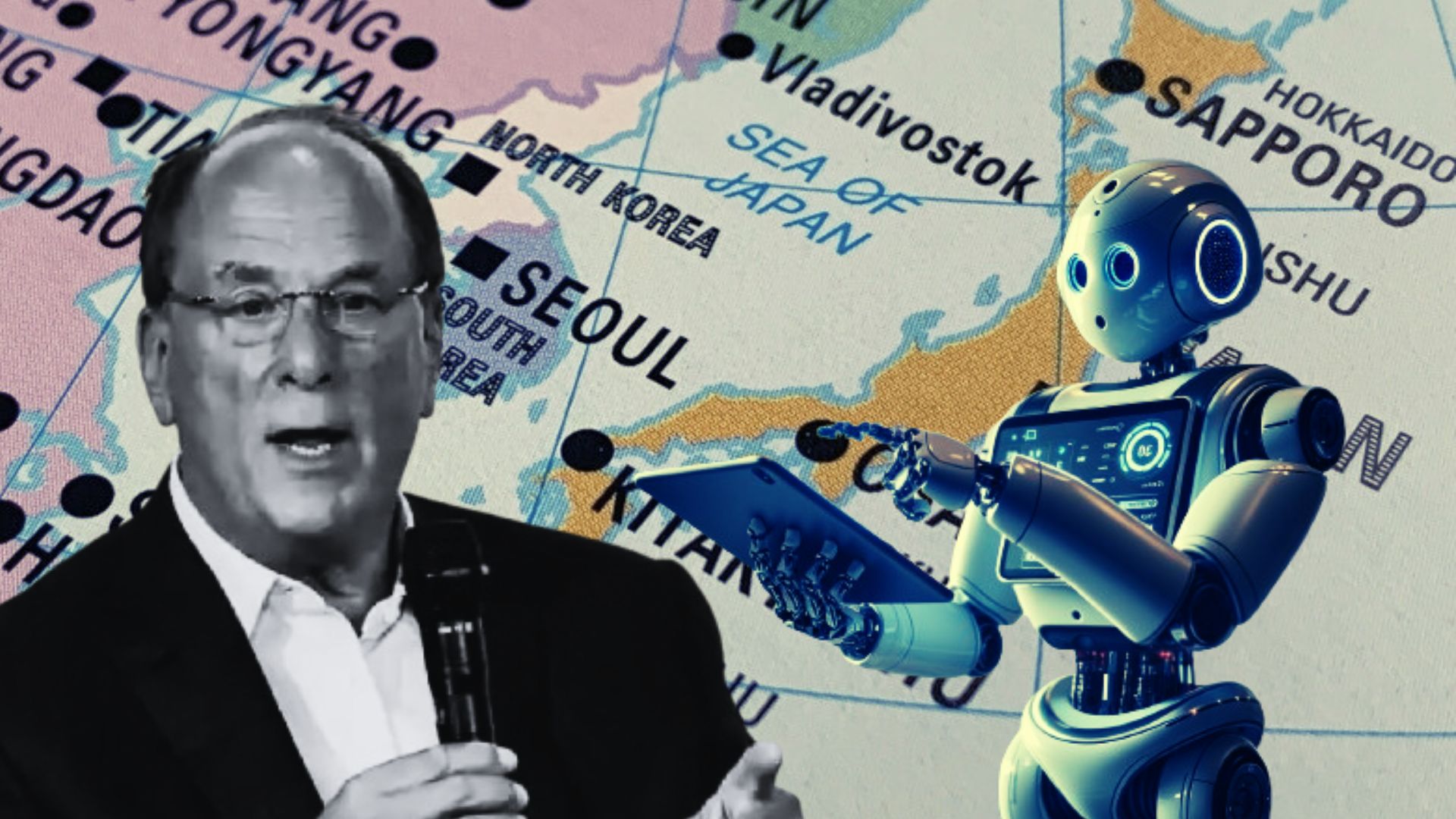Larry Fink, the CEO of BlackRock and arguably one of the most powerful men on the planet, is now openly saying that the countries with xenophobic immigration policies are going to have a higher standard of living, faster productivity growth, and will be better able to accomdate the social impact of artificial intelligence advances over the coming years.
“You know, we always used to think shrinking population is a cause for negative growth. But in my conversations with the leadership of these large developed countries that have xenophobic immigration policies, they don’t allow anybody to come in, shrinking unemployment, excuse me, shrinking demographics. These countries will rapidly develop robotics and AI and technology. And if the promise, I didn’t say it’s going to happen, but as a promise of all that transforms productivity, which most of us think it will, we’ll be able to elevate the standard of living of countries and the standard of living of individuals even with shrinking populations,” said Fink.
“And so the paradigm of negative population growth is going to be changing. And the social problems that one will have in substituting humans for machines is going to be far easier in those countries that have declining populations,” he said.
Larry Fink, CEO of @BlackRock, says developed nations with "xenophobic" immigration policies are going to have a higher standard of living than ever before.
Non-xenophobic countries are going to have social problems with their new 3rd world immigrants. pic.twitter.com/XkDvBgFUsY
— National Conservative (@NatCon2022) January 15, 2025Fink’s BlackRock manages $10.6 trillion in assets and has access to world leaders, CEOs, and some of the brightest minds on the planet, so when he speaks, people should listen whether they like what he is saying or not.
When Fink talks about xenophobic countries, he is talking about countries like South Korea, China, and Japan, where robotics and AI are being used to deal with the demographic situation instead of mass immigration. Of course, it must be noted that Fink himself has played a key role in driving DEI policies in corporations. BlackRock has used its trillions in investment dollars to strong-arm companies to adopt these policies, but society is not only turning against the policies, but Fink and others may also see the writing on the wall with AI and automation, and how many of the Asian countries seem to be outperforming the West.
Examples abound of how these countries are rapidly replacing human labor, and some of the most dramatic changes have taken place in just the last few years, if not the last few months.
Japan, for example, is where food delivery robots are being deployed instead of migrants from Third World countries, the same migrants who in the West are forced to earn a pittance while enduring tenuous working conditions.
Meanwhile, China is deploying self-driving buses to shuttle people around instead of refugees. The autonomous vehicle trend is exploding, and it will only accelerate over the next five years to the point that most public transportation will be automated, and if there is any driver at all, he or she will only be there in emergencies. Notably, many of the accidents that do occur on public transport are due to human error.
South Korea features some of the most highly automated factories in the world. In fact, the country leads the world in robot density and features one robot per ten human workers in manufacturing. It has successfully replaced 10 percent of its workforce through automation. Those trends will only accelerate as humanoid robots are more and more able to fulfill human tasks, a development that will wipe out millions of factory jobs in the coming years.
Fink is arguing, in essence, that these “xenophobic” Asian countries will continue to lead in terms of automation in part due to their population decline, which makes innovation a necessity. In fact, the West’s reliance on waves of foreign labor, which has also become a serious burden on the social welfare system, has harmed productivity, as companies believe it is not necessary to innovate when many tasks can be solved with cheap labor.
It is not as if immigration has really led to an improved standard of living either. The United States, which has seen the largest influx of immigrants in the history of mankind, is continuously complaining of a labor shortage, including a “crisis” involving a lack of “skilled labor.” It appears that no matter how many millions arrive in the country from foreign countries, the skilled labor shortage only grows. Meanwhile, the U.S. has been battered by inflation, sky-high housing prices, and increasingly unlivable and highly segregated cities where random acts of violence are a part of “big city” life and where public transport is a daily exercise in whether you will be harassed, assaulted, or simply lit on fire and left to burn alive.
These countries are not only highly developed, but they actually thrive on a lack of open borders. Despite placing severe restrictions on immigration, they have a higher quality of living than many Western countries. In the schools, there is order and a rich environment for learning. On the streets, there is little fear of being assaulted or raped while out for a jog. There is of course crime, but when looking at crime statistics, for example, from multicultural France, the difference is incredible.
Automation will only advance from here
Although fully automated factories have faced challenges, Harvard Business School says a fully “lights-out factory” will be a reality due to AI.
“Robots are becoming more capable, flexible, and cost-effective, with embodied agents bringing the power of generative AI into the factory environment. Manufacturers must prepare for the inevitable disruption — or risk falling behind,” the authors write.
All of this obviously raises serious questions about the need for mass immigration. The demand for big business and corporations for skilled and unskilled labor is real; however, if these spots are not fulfilled, these businesses will turn to automation. When it comes to immigration in countries like Germany, many of the immigrants are either on social welfare or in low-skilled professions, and waves of automation will increasingly leave these migrants and native workers unemployed, likely competing for a smaller pool of jobs. On farms, there will be no need for farmworkers anymore either, reducing the need for seasonal labor.
Japan has the oldest farmers in the world, and it is rapidly turning to technology to overcome this massive demographic challenge.
“Due to depopulation and aging, the number of Japanese farmers will rapidly decrease,” says Atsushi Suginaka, director-general for policy coordination at Japan’s Ministry of Agriculture, Forestry and Fisheries (MAFF). “In order to maintain agricultural production, there are high expectations for ‘smart agriculture’ as a new style of agriculture that combines improved productivity and sustainability.
“The Japanese government has been promoting smart agriculture in fields and the improvement of smart agriculture technologies. As a result of these efforts, many of these technologies have already been put into practical use: automated tractors, pesticide spraying drones, remote-controlled mowers.”
There is no doubt that Japan is also turning to temporary workers and limited immigration; however, these immigrants have little chance of becoming citizens, are almost all from Asian countries with similar cultures, and are coming in very limited numbers. The long-term plan for Japan is obviously to focus on productivity and automation over immigration. This means Japan does not have to deal with poor educational integration, cultural polarization, daily gang rapes, large organized foreign criminal groups, and Islamic terror attacks. Perhaps most of all, it does not have to give up its culture to accommodate hundreds of cultures, languages, and mores from all over the world that actively degrade and marginalize Japanese culture.
After all, Japan has a beautiful country, a beautiful culture, and a rich diversity of peoples within its own nation, which stretches from the tropical Amami Islands in the south to the Northern Japanese Alps. Westerners are increasingly fascinated with the lifestyle presented by Asian countries, which feature safe and luxurious public transport, clean and safe cities, and in many areas, far greater technological progress than the West. Youtube is, for example, rife with videos featuring tens of millions of views simply of individuals traveling on Asian train networks. There is nobody screaming, no threat of random stabbing attacks, and a level of service that simply could not exist on most Western trains.
Shockingly, Western rail networks are falling to pieces, and countries like Germany featured a record number of train delays in 2023, all while raising fare prices year after year. In New York City, the city’s own data on subway performance paints a miserable picture. Xenophobic Japan, in contrast, supplies incredible rail service and has not raised rail ticket fees for decades.
Japan’s functioning rail system may have less to do with automation than just practical human engineering and organization skills, but undoubtedly, Japan has invested in its train systems in a manner that works, which does include technology upgrades. This same progress is seen in a variety of fields, and even the International Monetary Fund (IMF) admits that Japan is managing its shrinking workforce through automation advancements.
The Asian countries get away “morally” with their xenophobia due to the fact that they are not White countries. Notice that Fink does not refer to them as “racist.” Xenophobia comes across as a softer more “technocratic” term. Only White countries must embrace diversity and mass immigration or face the dreaded “r” word.
Ultimately, the crisis will come when it becomes more and more apparent that humans are just not needed as much, and Fink realizes this, noting that those countries with a falling population will be better able to accommodate the falling demand for labor. Furthermore, homogenous societies like China, Japan and South Korea feature far more social cohesion than the increasingly polarized and fractured societies of the West, which enable these societies to better manage the social disruption brought on by AI.
The Chinese, for example, are far more optimistic than their European counterparts about the ability of AI to generate new jobs and opportunities. An Ipsos survey shows that 77 percent of Chinese believe AI will likely create new jobs in their country, making them the most optimistic country in the world. Europeans appear to see AI as a threat. Only 29 percent of Poles and Germans believe AI will likely create jobs.
The crisis will be huge
Goldman Sachs predicts 300 million jobs will be replaced or degraded in the Western world due to AI, hitting nearly every sector, including legal, engineering, healthcare, sales and design. Already in 2019, it was predicted by Oxford Economics that automation would replace 20 million factory workers by 2030. The same report writes that those same laid-off workers could try to enter the service sector, but they would find that those jobs too were dramatically reduced due to AI.
AI is already threatening professions that require advanced cognitive skills, such as programming, medicine, and law. Doctors, for example, are facing the reality that AI is far better than doctors at diagnosing illnesses. Already, many surgeries are performed by robotics, which are far more precise than doctors could ever be. Within 10 years, there will be no real need for doctors either.
Even in the skilled trade professions, such as factory workers, plumbers, gardeners, electricians, and other “physical jobs,” humanoid robots and other robots will increasingly muscle in on these jobs. Humanoid robots are in many ways just a far more advanced research problem than the one faced in developing self-driving vehicles. The self-driving car problem has been largely solved, it is just a matter of scaling it out further. However, you can now get into a Waymo car in San Franciso, and it can bring you from point A to point B, all without human intervention. Millions of people think that the “last-mile” problem is still a thing, but it’s not. There are hundreds of thousands of people driving the last mile every single day in their vehicles in the United States. There were many predicting even just a few years ago that this would not happen, that we were still decades away from self-driving vehicles, but it is happening in cities like San Francisco, Los Angeles, and Phoenix. Tesla drivers across the country are using full autonomous support to drive between cities without any intervention.
The same advances will happen with humanoid robots. In the end, they simply need to navigate 3-D space, learn from their environment through AI deep learning, and eventually solve problems even if they have not seen the problem before.
All of this also has the recipe for a disaster for humanity, freeing humans from labor, but removing their agency and sense of self-worth. It will also continue the trend of concentrating wealth, increase surveillance powers, and dramatically reduce the bargaining power of workers. Some industries may be able to ride out these changes, such as government workers or teachers, who have highly protected jobs, but on the whole, fewer and fewer people will be needed to participate to get the same outputs — if not better outputs.
The dream that the machines would do all the work so humans could “make art” and live a life of happy leisure has been made a mockery of through generative AI art and the doom scrolling that constitutes how many humans now spend their free time. This issue of AI and automation truly transcends all political ideologies, but political ideologies will almost certainly influence how each country manages these changes. The xenophobic countries will also face these challenges, but they are now in a position to reap the full gains of their xenophobic policies, and even Larry Fink is admitting as much.






